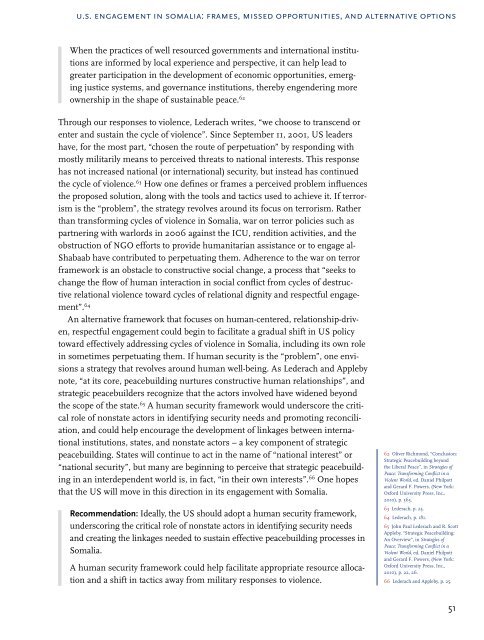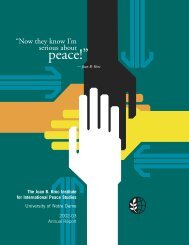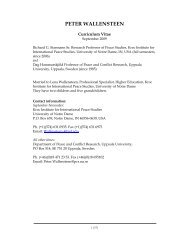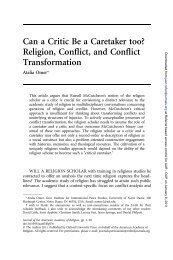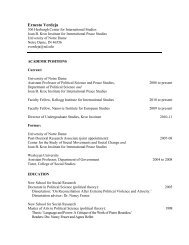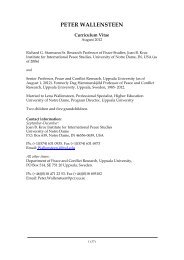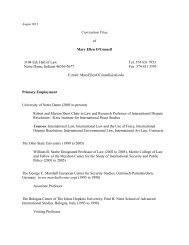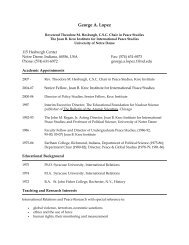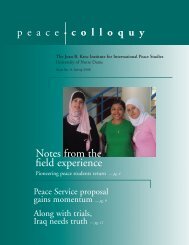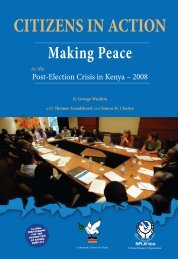Somalia: Creating Space for Fresh Approaches to Peacebuilding
Somalia: Creating Space for Fresh Approaches to Peacebuilding
Somalia: Creating Space for Fresh Approaches to Peacebuilding
You also want an ePaper? Increase the reach of your titles
YUMPU automatically turns print PDFs into web optimized ePapers that Google loves.
u.s. engagement in somalia: frames, missed opportunities, and alternative options<br />
When the practices of well resourced governments and international institutions<br />
are in<strong>for</strong>med by local experience and perspective, it can help lead <strong>to</strong><br />
greater participation in the development of economic opportunities, emerging<br />
justice systems, and governance institutions, thereby engendering more<br />
ownership in the shape of sustainable peace. 62<br />
Through our responses <strong>to</strong> violence, Lederach writes, “we choose <strong>to</strong> transcend or<br />
enter and sustain the cycle of violence”. Since September 11, 2001, US leaders<br />
have, <strong>for</strong> the most part, “chosen the route of perpetuation” by responding with<br />
mostly militarily means <strong>to</strong> perceived threats <strong>to</strong> national interests. This response<br />
has not increased national (or international) security, but instead has continued<br />
the cycle of violence. 63 How one defines or frames a perceived problem influences<br />
the proposed solution, along with the <strong>to</strong>ols and tactics used <strong>to</strong> achieve it. If terrorism<br />
is the “problem”, the strategy revolves around its focus on terrorism. Rather<br />
than trans<strong>for</strong>ming cycles of violence in <strong>Somalia</strong>, war on terror policies such as<br />
partnering with warlords in 2006 against the ICU, rendition activities, and the<br />
obstruction of NGO ef<strong>for</strong>ts <strong>to</strong> provide humanitarian assistance or <strong>to</strong> engage al-<br />
Shabaab have contributed <strong>to</strong> perpetuating them. Adherence <strong>to</strong> the war on terror<br />
framework is an obstacle <strong>to</strong> constructive social change, a process that “seeks <strong>to</strong><br />
change the flow of human interaction in social conflict from cycles of destructive<br />
relational violence <strong>to</strong>ward cycles of relational dignity and respectful engagement”.<br />
64<br />
An alternative framework that focuses on human-centered, relationship-driven,<br />
respectful engagement could begin <strong>to</strong> facilitate a gradual shift in US policy<br />
<strong>to</strong>ward effectively addressing cycles of violence in <strong>Somalia</strong>, including its own role<br />
in sometimes perpetuating them. If human security is the “problem”, one envisions<br />
a strategy that revolves around human well-being. As Lederach and Appleby<br />
note, “at its core, peacebuilding nurtures constructive human relationships”, and<br />
strategic peacebuilders recognize that the ac<strong>to</strong>rs involved have widened beyond<br />
the scope of the state. 65 A human security framework would underscore the critical<br />
role of nonstate ac<strong>to</strong>rs in identifying security needs and promoting reconciliation,<br />
and could help encourage the development of linkages between international<br />
institutions, states, and nonstate ac<strong>to</strong>rs – a key component of strategic<br />
peacebuilding. States will continue <strong>to</strong> act in the name of “national interest” or<br />
“national security”, but many are beginning <strong>to</strong> perceive that strategic peacebuilding<br />
in an interdependent world is, in fact, “in their own interests”. 66 One hopes<br />
that the US will move in this direction in its engagement with <strong>Somalia</strong>.<br />
Recommendation: Ideally, the US should adopt a human security framework,<br />
underscoring the critical role of nonstate ac<strong>to</strong>rs in identifying security needs<br />
and creating the linkages needed <strong>to</strong> sustain effective peacebuilding processes in<br />
<strong>Somalia</strong>.<br />
A human security framework could help facilitate appropriate resource allocation<br />
and a shift in tactics away from military responses <strong>to</strong> violence.<br />
62 Oliver Richmond, “Conclusion:<br />
Strategic <strong>Peacebuilding</strong> beyond<br />
the Liberal Peace”, in Strategies of<br />
Peace: Trans<strong>for</strong>ming Conflict in a<br />
Violent World, ed. Daniel Philpott<br />
and Gerard F. Powers, (New York:<br />
Ox<strong>for</strong>d University Press, Inc.,<br />
2010), p. 363.<br />
63 Lederach, p. 25.<br />
64 Lederach, p. 181.<br />
65 John Paul Lederach and R. Scott<br />
Appleby, “Strategic <strong>Peacebuilding</strong>:<br />
An Overview”, in Strategies of<br />
Peace: Trans<strong>for</strong>ming Conflict in a<br />
Violent World, ed. Daniel Philpott<br />
and Gerard F. Powers, (New York:<br />
Ox<strong>for</strong>d University Press, Inc.,<br />
2010), p. 22, 26.<br />
66 Lederach and Appleby, p. 25.<br />
51


